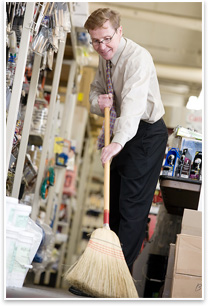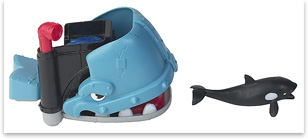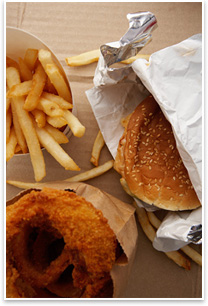 Four Surefire Steps to Recession-Proof Your Firm Four Surefire Steps to Recession-Proof Your Firm
by Jay Arthur
The KnowWare Man
Summary: When the economy falls off a cliff like it did in September 2008, is your firm going to survive or even thrive? Most firms reacted to the downturn by cutting the usual costs: training, travel, raises, bonuses, headcount, and 401(k) matching contributions. The bad news is these kinds of cuts also put employees in a funk that crushes productivity by one-third or more.
 Some firms are cutting corners on quality, but clients are even more savvy in a recession. These shortcuts may save a few dollars now, but ultimately they kill the cash cow because your clients will start shopping around. So, how do you cut the red ink without cutting corners or killing the cash cow? Fortunately, there are simple things you can do right now to cut the red ink, build client loyalty, and recession-proof your firm. And, since employees may not be as busy as they used to be, now is the perfect time to simplify, streamline, and optimize your firm. Some firms are cutting corners on quality, but clients are even more savvy in a recession. These shortcuts may save a few dollars now, but ultimately they kill the cash cow because your clients will start shopping around. So, how do you cut the red ink without cutting corners or killing the cash cow? Fortunately, there are simple things you can do right now to cut the red ink, build client loyalty, and recession-proof your firm. And, since employees may not be as busy as they used to be, now is the perfect time to simplify, streamline, and optimize your firm.
Step 1: Spring cleaning
Any workplace collects clutter: unused forms, materials, equipment, etc. Borrowing from the principles of Lean manufacturing, the first step is the five S’s: sort, straighten, shine, standardize, and sustain the workplace. Go through every nook and cranny and sell or throw out anything that you no longer use or need, because it just takes up space and wastes time and energy. Then organize and label everything. Then put a procedure in place to keep it clean and tidy. Even computer hard drives and servers can benefit from these five S's.
 Step 2: The fast eat the slow Step 2: The fast eat the slow
Spring cleaning will start to give you some idea about the existing workflow. Firms grow and expand organically, but rarely in an organized fashion. A process that started simple may have become wildly complex, slow, and error-prone. The gaps between steps in the process are killing productivity and creating too many opportunities for mistakes. The next step is to streamline the workflow.
The 3-57 Rule: Employees work on the product or service for only three minutes out of every hour of elapsed time. The product or service (and client) are waiting for something to happen for the other 57 minutes. Most people don't believe this until they map the workflow and put times on each activity and the time between activities. Ninety-five percent of all delay is in the gaps between processing steps. Most companies fail because they try to make their employees faster; the secret is to make your product faster.
While haste makes waste when you focus on the 3 minutes employees work on the product or service, speed makes profit when you eliminate the 57 minutes of delay.
The 15-2-20 Rule: Every 15 minute reduction in delay will double productivity and increase profit margins by 20 percent according to Stauk and Hout, authors of Competing Against Time (1990). By redesigning the workflow to eliminate delays, it's not unusual to reduce total time by 75 percent or more. Use a pad of Post-it™ notes to diagram the process, put times on every activity and gap, then redesign the process to minimize delays. It's that easy.
Simplifying and streamlining the workflow can be done quickly with the wisdom of employees, many of whom have been waiting for an opportunity to tune up the flow.
 Step 3: Optimize Step 3: Optimize
Do you ever stop and check your order before leaving a fast food drive thru? Why? Experience has taught you restaurants make too many mistakes and you can't afford to drive back. You've become an unpaid inspector in the fast food company's workflow, just as your clients have become an unpaid inspector in yours.
What is the cost of billing adjustments, rework, and so on? In most companies, one employee out of every three is engaged in the “Fix-It Factory,” correcting mistakes made by the other two. But don't blame the people blame the process, because it let the employee make the mistake. Once you've simplified and streamlined the workflow, the next step is to reduce the primary causes of mistakes, errors, and defects in the product or service.
The 4-50 Rule: While most people mistakenly believe that errors are evenly distributed over the firm like butter on bread, less than four percent of the firm is causing over 50 percent of the mistakes, rework, and lost profit. A short period of data collection will start to pinpoint the most error-prone processes, steps, or whatever. Then ask why, why, why, why, why? The most common wrong answers to these questions are: the people aren't trained or we don't have enough people, time, or money. You don't need more people, training, time, or money. You need a better process.
Hint: Don't try to fix your people or your product, fix your process.
Redesign the process so that it's impossible, even for an untrained employee, to make the mistake. Redesign the service so that employees cannot miss a step or do one twice. It takes more creativity and thought to figure out how to mistake-proof your process, but it will prevent problems forever. It will prevent client calls and the loss of clients to competitors.
Tip: Don't try to do this everywhere because it invokes the dark side of the 4-50 rule: 50 percent of the effort will only produce four percent of the benefit.
 Step 4: Repeat Step 4: Repeat
The good news is you can start today to simplify, streamline, and optimize your firm to make it recession proof. The bad news is you will never be done. Products change. Services change. Markets change. Technology changes. There will always be something to simplify, streamline, or optimize.
The economy will recover, but will you survive until then? These methods are easy to apply to start trimming the red ink without cutting corners or killing the cash cow. When the next downturn comes, as they always do, will you be recession proof?
|




 Step 2: The fast eat the slow
Step 2: The fast eat the slow Step 3: Optimize
Step 3: Optimize Step 4: Repeat
Step 4: Repeat